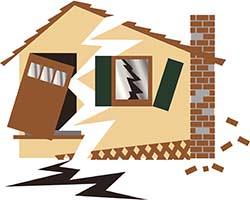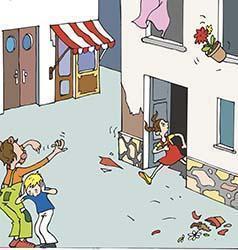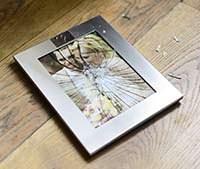Safe house for earthquake
Post from EditorialsIt is possible to secure your home in case of an earthquake by taking some simple precautions and rules of behavior at very low cost.
Why prevent the seismic risk
 As Italy is a country of high seismic risk, it is very important to think not only to obtain appropriate information about what behaviors to adopt during a earthquake, but above all how to increase the security of your house, as regards both the building itself (on which in case of renovation is always possible to intervene in order to improve performance during a seismic event), and the furnishing, in order to minimize the dangers in the event of tremors.
As Italy is a country of high seismic risk, it is very important to think not only to obtain appropriate information about what behaviors to adopt during a earthquake, but above all how to increase the security of your house, as regards both the building itself (on which in case of renovation is always possible to intervene in order to improve performance during a seismic event), and the furnishing, in order to minimize the dangers in the event of tremors.
In fact, during a non particularly destructive earthquake - that is, with damage related to the VII-VIII grade of Mercalli Scale, in which buildings are damaged too badly but there are a few crashes - most people is not hurt because buried in the rubble, but is injured following the fall of furniture and heavy objects, breaking window panes and the collapse of pieces of plaster, chimneys and cornices: it is therefore possible to avoid such risks by practicing the simple steps outlined in this article.
What to do before the earthquake
 Before the earthquake, it is therefore essential to remove from your house any potential risk element, consists mainly of:
Before the earthquake, it is therefore essential to remove from your house any potential risk element, consists mainly of:
- Tall furniture not properly fixed to the wall (cabinets, dressers and bookcases), which tend to tip over during a shock collapsing on the occupants and obstructing the possible escape routes;
- Heavy objects contained within furniture, and in particular the crockery of glass and ceramics, which falling from above and breaking can cause severe cuts;
- Mirrors, glass doors and windows, exploding easily firing shrapnel razor sharp;
- Internal stairs, especially if furniture and self-supporting, that during the shock could break or collapse.
It is still possible to limit these risks by implementing a few simple steps at a very low cost:
- Do not place the bed very close to a window or to a large mirror large;
- Does not hang over the bed heavy objects, such as carvings or bulky frames, especially if equipped with glass;
- If above the bed there is a bookcase, a built-in bridge or some shelves, do not place heavy objects (vases, sculptures, televisions, aquariums, very voluminous books);
- Equipping the kitchen cabinets and cupboards of an opening system or magnetic-type push-pull, to prevent even slight shock will cause the accidental opening;
- Anchor tall furniture to the wall with special devices (generally provided by the same companies, or readily available at any hardware store and articles of do-it-yourself), and place the larger and heavyer items on the lower shelves;
- Protect the windows and interior doors with transparent films, specially designed for this purpose and very useful in case of strong wind, falling or accidental bumps.
It is also advised to plan carefully what to do in case of an earthquake, providing in advance to:
- Identify a safe place (or better still a safe place for each room of the house) to retreat during the earthquake: are particularly suitable to crouch below desks, high beds and/ or sturdy tables (an excellent example are the antique furniture in solid wood, while are to be obviously avoided glass tables and those that are very close to windows or glass doors, large mirrors and tall furniture not adequately secured), the compartment door (preferably within a main wall) and the intersection between two supporting walls, especially if in the inner part of the building (which is usually less damaged than the facades);
- Keep in an easily accessible place a small emergency kit, consisting of a few blankets, one or more flashlights, a whistle and a few bottles of water (to be updated periodically), and take it with you if you go out: these objects could prove essential, if you end up trapped or buried in the rubbles, they would make possible to escape the cold, to not suffer thirst and to be easily identified by the rescuers;
- Know the location of meters of gas, water and electricity;
- Ensure that all members of the family and the regulars of the house (including elderly and children) know what to do during an earthquake, and also know the safe places and escape route to be used;
- Establish a meeting place where you can meet after the tremor: it must be an outdoor place (a garden, a wide street, a square or a public park) and away from any danger (other unsafe buildings, landslides, flooding, lines overhead power, gas leaks).
What to do during an earthquake
 If during the earthquake you are at home, you have to reach in the shortest possible time the shelter previously identified, and wait for the end of the shock trying to cover your head with your arms or - better yet - with a pillow or blanket: escaping during an earthquake is in fact extremely dangerous, not only because you could end up overwhelmed by the collapse of the stairs or a wall, but mostly because, once outside, you would easily be hit by debris, tiles, glass splinters or suspended objects (eg flower pots).
If during the earthquake you are at home, you have to reach in the shortest possible time the shelter previously identified, and wait for the end of the shock trying to cover your head with your arms or - better yet - with a pillow or blanket: escaping during an earthquake is in fact extremely dangerous, not only because you could end up overwhelmed by the collapse of the stairs or a wall, but mostly because, once outside, you would easily be hit by debris, tiles, glass splinters or suspended objects (eg flower pots).
If the tremor occurs at night, the safest thing is to stay in bed, covering your head with the pillow and snuggling up as much as possible: escaping in the dark - just to get to a safe place within the building - is in fact extremely dangerous.
What to do after the earthquake
 Once the earthquake had stopped, you must follow these rules of conduct:
Once the earthquake had stopped, you must follow these rules of conduct:
- First, before you go out make sure to wear shoes, because the floor could be strewn with shards of glass, wood and sharp rubble;
- If possible, bring your emergency kit designed for this purpose;
- If the building does not appear in immediate danger of collapse, before exiting close the gas, water and electricity meters: this is very important, because the ripped electricity cables, could cause electric shock, and also one of the greatest dangers in case of earthquake is constituted precisely by fires due to gas leaks;
- Abandon the building, strictly avoid the elevators, and on the stairs walk with caution while staying close to the wall, which is usually the part of the stairwell less subject to the risk of collapsing during earthquakes;
- If the stairs have collapsed or are unsafe, you can try to escape from the windows of a low floor (ground floor or first floor), but otherwise you need to wait for rescuers signaling your presence with shouts, sounding the whistle and/ or rhythmically turning the torch.
79163 REGISTERED USERS










